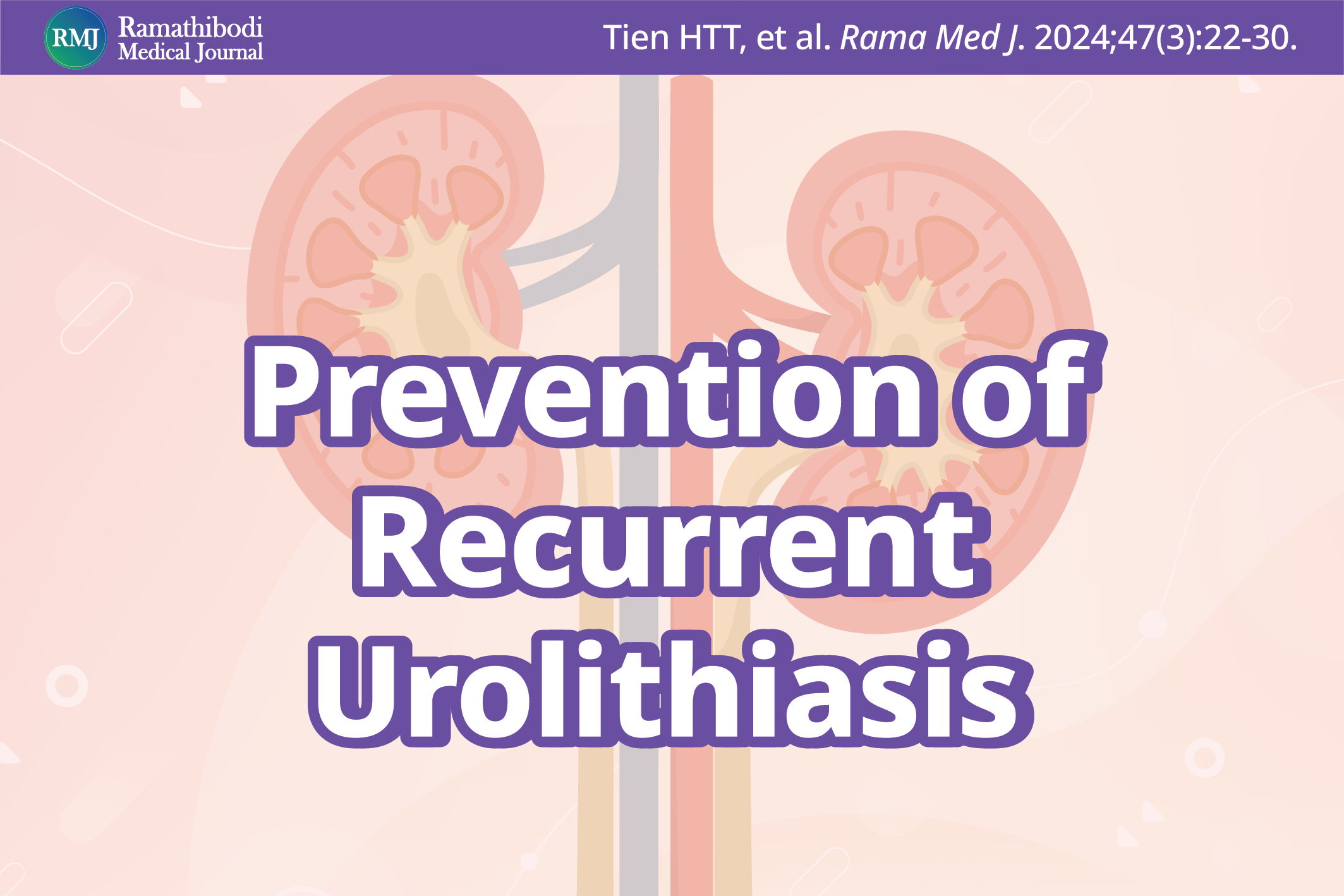A Cross-Sectional Study on Hospital-Based Knowledge Regarding Prevention of Recurrent Urolithiasis
DOI:
https://doi.org/10.33165/rmj.2024.47.3.268262Keywords:
Urolithiasis, Recurrent, Prevention, KnowledgeAbstract
Background: Urolithiasis which is a prevalent disease that can be prevented. Additionally, the rate of recurrence has been increasing. Prevention of the recurrence plays a vital role in limiting complications. One of the best ways to achieve this is by enhancing patients’ knowledge about preventing urolithiasis. However, there are few studies conducted on this issue in Vietnam.
Objectives: To explore the level of knowledge regarding the prevention of urolithiasis recurrence and identify predicted factors.
Methods: A cross-sectional design was used in the study. The respondents were over 18 years, used to diagnose urolithiasis, and attended the Department of Medical Examination and General Surgery Ward of C Da Nang Hospital. Ethical approval was obtained from the university and the hospital. Frequency and descriptive tests were applied to describe variables. Binominal logistic regression was used for detecting factors predicting knowledge regarding the prevention of urolithiasis recurrence.
Results: There were 254 patients participating in the study, and 68.9% of participants had good knowledge toward prevention of urolithiasis recurrence. The study revealed that occupation, duration of urolithiasis, number of hospitalizations, and source of information were significantly predictable factors (P < .05). Age, gender, residence, educational level, and treatment methods did not affect this knowledge.
Conclusions: Improving knowledge regarding the prevention of recurrent urolithiasis in patients was important, especially in general knowledge and diet including fluid intake. The development should be through the source of obtained information. It is necessary to emphasize the role of healthcare workers in providing the appropriate information.
References
Liu Y, Chen Y, Liao B, et al. Epidemiology of urolithiasis in Asia. Asian J Urol. 2018;5(4):205-214. doi:10.1016/j.ajur.2018.08.007
Alelign T, Petros B. Kidney stone disease: an update on current concepts. Adv Urol. 2018;2018:3068365. doi:10.1155/2018/3068365
Sorokin I, Mamoulakis C, Miyazawa K, Rodgers A, Talati J, Lotan Y. Epidemiology of stone disease across the world. World J Urol. 2017;35(9):1301-1320. doi:10.1007/s00345-017-2008-6
Thuy NTL. Changing knowledge about preventing kidney stone recurrence among patients undergoing kidney stone surgery after health education at Nam Dinh Provincial General Hospital.Journal of Nursing Science. 2022;5(2):41-48.
Bhojani N, Bjazevic J, Wallace B, et al. UPDATE-Canadian urological association guideline: evaluation and medical management of kidney stones. Can Urol Assoc J. 2022;16(6):175-188. doi:10.5489/cuaj.7872
Hesswani C, Iqbal S, Zand KR, et al. Identifying risk factors for development of nephrolithiasis in end-stage renal disease patients. Can Urol Assoc J. 2020;14(5):E185-E190. doi:10.5489/cuaj.6017
Tzelves L, Berdempes M, Mourmouris P, Mitsogiannis I, Skolarikos A. Optimal delivery of follow-up care for the prevention of stone recurrence in urolithiasis patients: improving outcomes. Res Rep Urol. 2022;14:141-148. doi:10.2147/rru.S277498
Baatiah NY, Alhazmi RB, Albathi FA, Albogami EG, Mohammedkhalil AK, Alsaywid BS. Urolithiasis: prevalence, risk factors, and public awareness regarding dietary and lifestyle habits in Jeddah, Saudi Arabia in 2017. Urol Ann. 2020;12(1):57-62. doi:10.4103/ua.Ua_13_19
Hang PT. Current status of knowledge and practice on preventing urinary stone recurrence in diabetic patients at Nam Dinh General Hospital in 2020. Vietnam Medical Journal. 2023;527(2):251-256. doi:10.51298/vmj.v527i2.5895
Dirie NI, Adam MH, Garba B, et al. The prevalence of urolithiasis in subjects undergoing computer tomography in selected referral diagnostic centers in Mogadishu, Somalia. Front Public Health. 2023;11:1203640. doi:10.3389/fpubh.2023.1203640
Qian X, Wan J, Xu J, et al. Epidemiological trends of urolithiasis at the global, regional, and national levels: a population-based study. Int J Clin Pract. 2022;2022:6807203. doi:10.1155/2022/6807203
Wang K, Ge J, Han W, et al. Risk factors for kidney stone disease recurrence: a comprehensive meta-analysis. BMC Urol. 2022;22(1):62. doi:10.1186/s12894-022-01017-4
Huong NTT. Current Status of Knowledge on Preventing Urinary Stone Recurrence Among Patients at Nam Dinh Provincal General Hospital. Nam Dinh University of Nursing; 2018.
Moussa M, Abou Chakra M. Patient’s perception of kidney stone prevention within the emergency department and its adherence factors: a single institution study. BMC Emerg Med. 2019;19(1):48. doi:10.1186/s12873-019-0263-0
Aldaher HS, Kadhim SZ, Al-Roub NM, Alsadi AH, Salam DA, Tillo EA. Evaluating the understanding about kidney stones among adults in the United Arab Emirates. J Taibah Univ Med Sci. 2021;16(5):788-793. doi:10.1016/j.jtumed.2021.04.005
Bazyar H, Ahmadi A, Zare Javid A, Irani D, Mohammadi Sartang M, Haghighizadeh MH. The association between dietary intakes and stone formation in patients with urinary stones in Shiraz. Med J Islam Repub Iran. 2019;33:8. doi:10.34171/mjiri.33.8
Ferraro PM, Bargagli M. Dietetic and lifestyle recommendations for stone formers. Arch Esp Urol. 2021;74(1):112-122.
Siener R. Nutrition and kidney stone disease. Nutrients. 2021;13(6):1917. doi:10.3390/nu13061917
Bao Y, Tu X, Wei Q. Water for preventing urinary stones. Cochrane Database Syst Rev. 2020;2(2):CD004292. doi:10.1002/14651858.CD004292.pub4
Nirumand MC, Hajialyani M, Rahimi R, et al. Dietary plants for the prevention and management of kidney stones: preclinical and clinical evidence and molecular mechanisms. Int J Mol Sci. 2018;19(3):765. doi:10.3390/ijms19030765
Gamage KN, Jamnadass E, Sulaiman SK, Pietropaolo A, Aboumarzouk O, Somani BK. The role of fluid intake in the prevention of kidney stone disease: a systematic review over the last two decades. Turk J Urol. 2020;46(Supp. 1):S92-S103. doi:10.5152/tud.2020.20155
Barghouthy Y, Somani BK. Role of citrus fruit juices in prevention of kidney stone disease (KSD): a narrative review. Nutrients. 2021;13(11):4117. doi:10.3390/nu13114117
Gumaih HS, Alasbahy A, Alharethi SH, Al-Asmari SM, Al-Khulaidi AWA. Antiurolithiasis activities of Zea mays extract and its mechanism as antiurolithiasis remedy. Am J Clin Exp Urol. 2023;11(5):443-451.
Le TNP, Felix MS, Ratanawijitrasin S, Paek SC. Beliefs and traditional medicine use among vietnamese older adults: the case study in Hoc Mon District. JPSS. 2023;31:381-402.
Adawi E, Mahzara NK, Hadaddi R, et al. Awareness of urinary stone risk factors among the adult population of Jazan, Saudi Arabia: a cross-sectional study. Cureus. 2023;15(11):e49115. doi:10.7759/cureus.49115
Reicherz A, Rausch P, Herout R, Noldus J, Bach P. An empirical study on hospital-based prevention of recurrent urinary stone disease in Germany. World J Urol. 2022;40(1):237-242. doi:10.1007/s00345-021-03813-3

Downloads
Published
How to Cite
Issue
Section
License
Copyright (c) 2024 by the Authors. Licensee Ramathibodi Medical Journal.

This work is licensed under a Creative Commons Attribution-NonCommercial-NoDerivatives 4.0 International License.
















